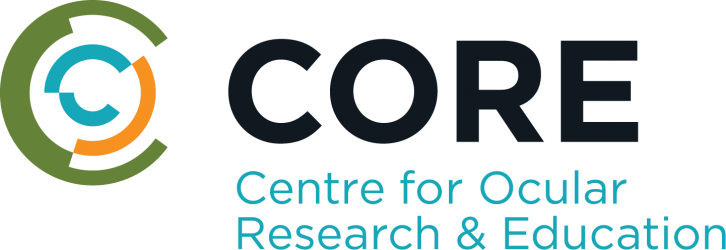Publications
Showing 25 results out of 580 in total.
Karlgard,C. C. S., Sarkar,D. K., Jones,L. W., Moresoli,C., Leung,K. T.
Drying methods for XPS analysis of PureVision™, Focus® Night&Day™ and conventional hydrogel contact lenses
Applied Surface Science 2004;230(1-4):106-114 [ Show Abstract ]
The surface composition of hydrogel contact lenses that contain silicon-based monomers, PureVision™ (balafilcon A) and Focus® Night&Day™ (lotrafilcon A), were investigated by X-ray photoelectron spectroscopy (XPS). Conventional and daily disposable hydrogel lenses based on hydroxyethyl methacrylate (HEMA) were also studied, with the commonly prescribed 1-day Acuvue® lens (etafilcon A) used as a control. All the lenses were pre-washed and dehydrated by three different methods, including drying in air, drying in nitrogen or freezing with subsequent freeze-drying, before the XPS analysis. The lenses dried in air had more impurities on the surface, and the lenses that were freeze-dried lost transparency, suggesting that drying lenses in nitrogen is the preferred preparation method for XPS analysis. Surface compositions for all lens materials were obtained and this data can be used as a control/base-value for future analysis of the interactions of soft contact lens materials with chemicals such as drugs or tear components. © 2004 Elsevier B.V. All rights reserved.
Karlgard,C. C. S., Wong,N. S., Jones,L. W., Moresoli,C.
In vitro uptake and release studies of ocular pharmaceutical agents by silicon-containing and p-HEMA hydrogel contact lens materials
International journal of pharmaceutics 2003;257(1-2):141-151 [ Show Abstract ]
The in vitro uptake and release behaviour of cromolyn sodium, ketotifen fumarate, ketorolac tromethamine and dexamethasone sodium phosphate with silicon-containing (lotrafilcon and balafilcon) and p-HEMA-containing (etafilcon, alphafilcon, polymacon, vifilcon and omafilcon) hydrogel contact lenses indicated that both drug and material affected the uptake and release behaviour. Rapid uptake and release (within 50min) was observed for all drugs except ketotifen fumarate which was more gradual taking approximately 5h. Furthermore, the maximum uptake differed significantly between drugs and materials. The highest average uptake (7879±684μg/lens) was cromolyn sodium and the lowest average uptake (67±13μg/lens) was dexamethasone sodium phosphate. Partial release of the drug taken up was observed for all drugs except dexamethasone sodium phosphate where no release was detected. Sustained release was demonstrated only by ketotifen fumarate. Drug uptake/release appeared to be a function of lens material ionicity, water and silicon content. The silicon-containing materials released less drug than the p-HEMA-containing materials. The lotrafilcon material demonstrated less interactions with the drugs than the balafilcon material which can be explained by their different bulk composition and surface treatment. © 2003 Elsevier Science B.V. All rights reserved.
Keech,A., Flanagan,J., Simpson,T., Jones,L.
Tear meniscus height determination using the OCT2 and the RTVue-100
Optometry and Vision Science 2009;86(10):1154-1159 [ Show Abstract ]
PURPOSE: To compare anterior segment spectral-domain optical coherence tomography (SOCT) tear meniscus height (TMH) measures with those from the more commonly used time-domain OCT (TOCT). METHODS: The right eye of 50 healthy subjects had images of their TMH captured with TOCT (OCT2) and SOCT (RTVue-100). Data were acquired using two different anterior segment lenses, the cornea/anterior module-short (CAM-S) and long (CAM-L), on the SOCT. Images were then analyzed for differences in their derived TMH. RESULTS: The average TMH for TOCT was 0.280 ± 0.139 mm, whereas the mean TMH measured using the SOCT was 0.354 ± 0.163 mm and 0.345 ± 0.167 mm for the CAM-S and CAM-L, respectively. There was a significant difference (p < 0.001) when comparing TOCT with either of the SOCT lenses. There was no statistically significant difference between the CAM-L and CAM-S (p = 1.0). Bland-Altman analysis showed poor agreement between TOCT and SOCT (95% limits of agreement -0.138 to + 0.285 mm for the CAM-S and -0.185 to +0.315 mm for the CAM-L). CONCLUSIONS: The RTVue-100 produces TMH measurements that are significantly higher than OCT2 in a normal patient population. However, the RTVue-100 showed a number of other advantages over the OCT2 in the measurement and analysis of images. Future work needs to determine the causative factors behind the observed differences.
Keech,A., Senchyna,M., Jones,L.
Impact of time between collection and collection method on human tear fluid osmolarity
Current eye research 2013;38(4):428-436 [ Show Abstract ]
Aim: To generate data on the variability of tear osmolarity in a control (normal, non-dry eye) and symptomatic dry eye population (Ocular Surface Disease Index: OSDI ≥20). A secondary outcome is the determination of the effect that tear collection technique has on the osmolarity of the sample. Materials and methods: This was a two-phase study that recruited 20 subjects (n = 10 normal, n = 10 dry eye) to evaluate the influence of time between measurements (Phase I) and 30 subjects (n = 15 normal, n = 15 dry eye) to evaluate the influence of collection technique (Phase II). As part of Phase I, serial tear osmolarity measurements were performed on each eye; four separated by 15min followed by four separated by lmin, at each of three visits. Phase II compared the consecutive measurement of four in vivo tear samples to four in vitro measurements on tears collected and dispensed from a glass capillary tube. Results: During Phase I, the dry eye group had a significantly higher maximum osmolarity (334.2 ± 25.6 mOsm/L) compared to the normal group (304.0 ± 8.4mOsm/L, p = 0.002). No significant differences were observed whether collections were performed at 15 or 1 min intervals. During Phase II, the in vivo osmolarity was equivalent to in vitro measurements from glass capillary tube samples for both the dry eye group (323.0± 16.7mOsm/L versus 317.7±24.8, p = 0.496), and for the normal subjects (301.2±7. 2mOsm/L versus 301.9 ± 16.0 mOsm/L, p = 0.884). Conclusion: Symptomatic dry eye subjects exhibited a significantly higher tear osmolarity and variation over time than observed in normal subjects, reflecting the inherent tear film instability of dry eye disease. There was no change in the distribution of tear osmolarity measurements whether tears were collected in rapid succession or given time to equilibrate, and collection method had no impact on tear osmolarity. © Informa Healthcare USA Inc.
Keech,A., Simpson,T., Jones,L.
Repeatability of pachymetry and thinnest point localization using a Fourier-domain optical coherence tomographer
Optometry and Vision Science 2010;87(10):736-741
Keir,N. J., Simpson,T., Hutchings,N., Jones,L., Fonn,D.
Outcomes of wavefront-guided laser in situ keratomileusis for hyperopia
Journal of cataract and refractive surgery 2011;37(5):886-893 [ Show Abstract ]
Purpose: To determine the impact of wavefront-guided laser in situ keratomileusis (LASIK) for hyperopia on corrected distance visual acuity (CDVA), contrast sensitivity, and higher-order aberrations (HOAs). Setting: Centre for Contact Lens Research, University of Waterloo, Waterloo, Ontario, Canada. Design: Case series. Methods: This study comprised patients who had LASIK for hyperopia. The HOAs up to the 4th order (5.0 mm pupil) in right eyes were analyzed. Results: The study enrolled 31 patients. The preoperative mean values were sphere, +2.60 diopters (D) ± 1.15 (SD) (range +1.00 to +5.00 D); astigmatism, -0.87 ± 0.74 D (range 0.00 to -3.75 D); and spherical equivalent (SE), +2.16 ± 1.00 D (range +0.63 to +4.50 D). The postoperative refractive SE was within ±0.50 D in 71.0% of eyes. The uncorrected distance visual acuity was 20/20 or better in 87.2% of eyes. There was no significant change in CDVA or contrast sensitivity (all P>.05). There was a significant change in Zernike coefficients Z(0,4), Z(-1,3), Z(-3,3), and Z(3,3) (range of mean absolute change ± SEM: 0.092 ± 0.013 μm to 0.208 ± 0.018 μm; all P<.001). Coefficients Z(-1,3) and Z(3,3) increased and Z(0,4) and Z(-3,3) decreased in magnitude; each had a reversal of sign. The only significant postoperative association was between low-contrast CDVA and Z(0,4) (r = 0.617, P<.001). Conclusions: Low-contrast CDVA after LASIK surgery for hyperopia was correlated with Z(0,4). There were no significant changes in CDVA or contrast sensitivity. The relative risk for losing low-contrast CDVA increased if more than 1 Zernike term had a sign change. Financial Disclosure: No author has a financial or proprietary interest in any material or method mentioned. © 2011 ASCRS and ESCRS.
Keir,N. J., Simpson,T., Jones,L. W., Fonn,D.
Wavefront-guided LASIK for myopia: Effect on visual acuity, contrast sensitivity, and higher order aberrations
Journal of Refractive Surgery 2009;25(6):524-533 [ Show Abstract ]
PURPOSE: To determine the impact of wavefrontguided LASIK for myopia with or without astigmatism on high and low contrast best spectacle-corrected visual acuity (BSCVA), photopic and mesopic contrast sensitivity, and higher order aberrations. METHODS: Bilateral wavefront-guided LASIK (LADARVision4000; Hansatome microkeratome) was performed on 324 eyes (162 patients) with a mean spherical manifest refraction of -2.84±1.35 diopters (D) (range: -0.25 to -6.50 D) and astigmatism of -0.81±0.74 D (range: 0 to -4.00 D). Mean age was 37.7±9.3 years (range: 20 to 60 years). Best spectacle-corrected visual acuity and contrast sensitivity were assessed using ETDRS charts and vertical sinusoidal gratings, respectively. Higher order aberrations were measured using a Shack-Hartmann wavefront sensor, analyzed across a 5-mm pupil. Repeated measures and post hoc analyses determined statistical significance (P<.0025). Only right eyes were analyzed. RESULTS: One hundred thirty-six eyes (84%) had uncorrected visual acuity of 20/20 or better 6 months postoperative; 80.9% (131 eyes) were within ±0.50 D of attempted correction. Statistically significant postoperative improvements were noted in high and low contrast BSCVA (both P≤.001); in photopic contrast sensitivity at 3, 6, and 12 cycles per degree (cpd); and in mesopic contrast sensitivity at 12 and 18 cpd (all P<.001). With respect to higher order aberrations, a statistically significant change was seen in Zernike coefficients Z 3 -1, Z 3 1, Z 3 -3, Z 3 3, and Z 3 4 following surgery (range of mean absolute change: 0.042 to 0.142 μm; all P<.001). All increased in magnitude except for Z 3 -3, which decreased. CONCLUSIONS: Despite an increase in higher order aberrations, wavefront-guided LASIK yields excellent visual acuity and contrast sensitivity. Spherical aberration, which increases the most following non-wavefront-guided LASIK, showed no significant change.
Keir,N., Jones,L.
Wettability and silicone hydrogel lenses: A review
Eye and Contact Lens 2013;39(1):100-108 [ Show Abstract ]
One of the major breakthroughs in the development of silicone hydrogel contact lenses has related to the ability of manufacturers to overcome the surface hydrophobicity that occurred with silicone elastomer lenses. However, the wettability of silicone hydrogel lenses continues to be of interest as a potential link between in vivo lens performance and contact lens-related comfort. This article will review some of the knowledge we have gained in the area of contact lens wettability over the past decade and will discuss some of the challenges related to its measurement. © 2013 Lippincott Williams & Wilkins.
Keir,N., Luensmann,D., Woods,C.A., Bergenske,P., Fahmy,M., Fonn,D.
Effect of Masking on Subjective Responses to Daily Disposable Contact Lenses
Optom Vis Sci 2016;93(8):828-35 [ Show Abstract ]
PURPOSE: To explore the effect of masking on subjective responses when wearing daily disposable (DD) contact lenses.
METHODS: In an adaptation phase, habitual wearers of Manufacturer-A (MFA) (n = 43) and Manufacturer-B (MFB) (n = 53) wore MFA-brand 1 or MFB-brand 1 DDs, respectively, for 30 days, open-label. Subjects were then randomly assigned to one of two experiments. Each experiment included two, 3-day crossover phases. An enhanced version of MFA and MFB lenses (MFA-brand 2 and MFB-brand 2) were worn contralaterally to evaluate potential differences in masking result between manufacturers. Experiment 1: subjects were fully masked to lens and packaging (FM) then unmasked (UM). Experiment 2: subjects were FM then partially masked using an over-label (PM). Comfort ratings (0-100) were recorded for each lens daily and preference between lenses was recorded on day 3 for each crossover phase. The mean difference between 0-100 ratings or preference when FM or PM versus UM for the same lens was considered a measurement of the effect associated with masking. The purpose of the study was withheld from subjects to minimize bias.
RESULTS: The effect associated with masking for habitual wearers of MFA and MFB lenses was less than 1 out of 100 (0 ± 2.5) in both experiments. Fifty-eight subjects (60%) expressed no preference when FM. This decreased to 29 (30%) when UM or PM (proportion test, p < 0.001). Approximately half the subjects had a change in lens preference when they were UM or PM, primarily in favor of their habitual lens manufacturer.
CONCLUSIONS: Masking did not have a measurable impact on 0-100 ratings with the DD lenses used in this study but did have an impact on lens preference. Subjects were more likely to express a preference when they handled the lenses and were exposed to the lens packaging and, in some cases, able to read the lens brand and lens manufacturer.
Keir,N., Simpson,T., Fonn,D.
Visual and optical performance of silicone hydrogel contact lenses for moderate myopia
Journal of Optometry 2010;3(3):149-157 [ Show Abstract ]
Purpose: To compare the short-term visual and optical performance of silicone hydrogel contact lenses for myopia = -3.00D. Methods: This was a short-term, non-dispense, double-masked, randomized study investigating Night&Day (ND), PureVision (PV), O2 Optix (O2), Biofinity (BF), Acuvue Advance (AA) and Acuvue OASYS for myopia = -3.00D. Testing was conducted under scotopic conditions. Measures (one eye only) included: high- and low-contrast visual acuity (HCVA/LCVA), contrast sensitivity, subjective clarity of vision ratings (0-100 scale using reference images, with test image representing grade 50) and ocular aberrations (up to the 4th order, analyzed across individual scotopic pupil sizes). Results: Three males and 27 females participated, with a mean (± SD) age of 24.9 ± 7.7 yrs (range 19 to 53 yrs), sphere of -5.30 ± 1.73D (range -3.00 to -10.75D) and cylinder -0.36 ± 0.23D (range 0 to -0.75D). Mean (± SEM) logMAR HCVA ranged from 0.06 (PV) to 0.10 (AA) (± 0.02), LCVA from 0.33 (BF) to 0.40 (AA) (± 0.02) and contrast sensitivity from 2.33 (BF) to 2.53 (ND) (± 0.15) (differences not statistically significant; all p > 0.05). Subjective ratings for the test image ranged from 59 (PV) to 64 (ND) (± 4) and 56 (AA) to 65 (ND) (± 4), for monochromatic and polychromatic reference images, respectively (all p > 0.05). There was a statistically significant impact on ocular aberrations with all study lenses compared to no lens. Between-lens differences were statistically significant for defocus (Z 0 2), horizontal coma (Z 1 3) and spherical aberration (Z 0 4). Conclusions: Despite some differences in ocular aberrations, there were no significant differences in HCVA, LCVA, contrast sensitivity or subjective ratings across lenses. © 2010 Spanish General Council of Optometry. Published by Elsevier España, S.L. All rights reserved.
Keir,N., Woods,C. A., Dumbleton,K., Jones,L.
Clinical performance of different care systems with silicone hydrogel contact lenses
Contact Lens and Anterior Eye 2010;33(4):189-195
Khanal,S., Bai,Y., Ngo,W., Nichols,K. K., Wilson,L., Barnes,S., Nichols,J. J.
Human meibum and tear film derived cholesteryl and wax esters in meibomian gland dysfunction and tear film structure: Cholesteryl and wax esters in meibomian gland dysfunction
Ocular Surface 2022;23(January):12-23 [ Show Abstract ]
Purpose
This study evaluated the presence and roles of cholesteryl esters (CEs) and wax esters (WEs) from human tear film and meibum in meibomian gland dysfunction (MGD).
Methods
Out of 195 enrolled subjects, 164 and 179 subjects provided tear and meibum samples, respectively. Subjects were classified into normal, asymptomatic MGD, MGD, and mixed (MGD & aqueous deficient). The precorneal tear film (PCTF) thinning rate (evaporation) was measured using optical coherence tomography. Lipids extracted from tear and meibum samples were infused into a SCIEX 5600 TripleTOF mass spectrometer. CE and WE intensities quantified with Analyst 1.7 TF and LipidView 1.3 were compared across disease groups in MetaboAnalyst 5.0 and correlated with PCTF thinning rates.
Results
The numbers of unique CEs and WEs identified in the samples were 125 and 86, respectively. Unsupervised Principal Component (PC) analysis and supervised Partial Least Square Discriminant analysis exhibited little separation among groups for both CEs and WEs in tears and meibum. Spearman's correlation analyses showed no association between either the first or second PC scores with PCTF thinning rates.
Conclusion
The abundances of human PCTF and meibum-derived CEs and WEs were independent of MGD disease status and PCTF thinning (evaporation). CEs and WEs alterations do not contribute to alterations in tear film dynamics in MGD, such as has been demonstrated by the (O-acyl) ω-hydroxy fatty acids (OAHFAs).
Khanal,S., Ngo,W., Nichols,K. K., Wilson,L., Barnes,S., Nichols,J. J.
Human meibum and tear film derived (O-acyl)-omega-hydroxy fatty acids in meibomian gland dysfunction
Ocular Surface 2021;21(July):118-128 [ Show Abstract ]
Purpose: The molecular basis of the tear film and lipid layer alterations in meibomian gland dysfunction (MGD) is unknown. This study aimed to identify and compare (O-acyl)-omega-hydroxy fatty acids (OAHFAs) derived from human meibum and tears in MGD. Methods: Of 195 eligible subjects (18–84 years, 62.6% female), 183 and 174 provided samples for tears and meibum, respectively. Subjects were classified into four groups: Normal, Asymptomatic MGD, MGD, and Mixed. Samples from the right eye of each subject were infused into the SCIEX 5600 TripleTOF mass spectrometer in negative ion mode. Lipid intensities identified with Analyst1.7 TF and SCIEX LipidView1.3 were normalized by an internal standard and total ion current, then statistically compared in MetaboAnalyst 4.0. Results: In meibum and tears, 76 and 78 unique OAHFAs were identified, respectively. The five most frequent and abundant OAHFAs were 18:2/16:2, 18:1/32:1, 18:1/30:1, 18:2/32:1, and 18:1/34:1. Two OAHFAs, 18:2/20:2 and 18:2/20:1, were identified only in tears. Initial univariate analysis revealed three differently regulated OAHFAs in meibum and eight in tears. Partial Least Square Discriminant Analysis showed 18:1/32:1, 18:2/16:2, 18:1/34:1 and 18:0/32:1 in tears, and 18:2/16:2, 18:1/32:1 and 18:2/32:2 in meibum, had variable importance in projection scores >1.5 and contributed the most to the separation of groups. In both meibum and tears, all OAHFAS except 18:2/16:2 were reduced in MGD compared to the normal group. Conclusion: MGD is accompanied by differential expression of specific OAHFAs in meibum and tears. These results suggest OAHFAs play a role in the altered biochemical profile of the tear film lipid layer in humans with MGD.
Klenkler,B., Sheardown,H., Jones,L.
Growth factors in the tear film: Role in tissue maintenance, wound healing, and ocular pathology
Ocular Surface 2007;5(3):228-239 [ Show Abstract ]
Numerous biologically active growth factors are secreted by the lacrimal gland and distributed via the tears over the ocular surface where they affect cellular proliferation, migration, differentiation, and survival. The role of growth factors and their receptors in maintenance of tissue homeostasis and wound healing continues to be elucidated, and the effect of growth factor imbalances In ocular surface diseases is just beginning to be understood. For Instance, in eyes with ocular surface diseases, Including conjunctivitis, corneal erosion, keratitis, and corneal ulcers, epidermal growth factor release rates have been shown to be significantly lower than in normal eyes during reflex tearing. Future research into the mechanisms of dry eye disease will focus on reasons for decreased tear and growth factor production in the neuronal reflex loop or the acinar lacrimal gland cells. Animal models to test therapeutic approaches must be developed. © 2007 Ethis Communications, Inc.
Kondela,T., Dushanov,E., Vorobyeva,M., Mamatkulov,K., Drolle,E., Soloviov,D., Hrubovcak,P., Kholmurodov,K., Arzumanyan,G., Leonenko,Z., Kucerka,N
Investigating the competitive effects of cholesterol and melatonin in model lipid membranes
Biochimica et Biophysica Acta - Biomembranes 2021;1863(9):183651 [ Show Abstract ]
We have studied the impact of cholesterol and/or melatonin on the static and dynamical properties of bilayers made of DPPC or DOPC utilizing neutron scattering techniques, Raman spectroscopy and molecular dynamics simulations. While differing in the amplitude of the effect due to cholesterol or melatonin when comparing their interactions with the two lipids, their addition ensued recognizable changes to both types of bilayers. As expected, based on the two-component systems of lipid/cholesterol or lipid/melatonin studied previously, we show the impact of cholesterol and melatonin being opposite and competitive in the case of three-component systems of lipid/cholesterol/melatonin. The effect of cholesterol appears to prevail over that of melatonin in the case of structural properties of DPPC-based bilayers, which can be explained by its interactions targeting primarily the saturated lipid chains. The dynamics of hydrocarbon chains represented by the ratio of trans/gauche conformers reveals the competitive effect of cholesterol and melatonin being somewhat more balanced. The additive yet opposing effects of cholesterol and melatonin have been observed also in the case of structural properties of DOPC-based bilayers. We report that cholesterol induced an increase in bilayer thickness, while melatonin induced a decrease in bilayer thickness in the three-component systems of DOPC/cholesterol/melatonin. Commensurately, by evaluating the projected area of DOPC, we demonstrate a lipid area decrease with an increasing concentration of cholesterol, and a lipid area increase with an increasing concentration of melatonin. The demonstrated condensing effect of cholesterol and the fluidizing effect of melatonin appear in an additive manner upon their mutual presence.
Korogiannaki,M., Guidi,G., Jones,L., Sheardown,H.
Timolol maleate release from hyaluronic acid-containing model silicone hydrogel contact lens materials.
J Biomat Appl 2015;30(3):361-376
Korogiannaki,M., Jones,L. W., Sheardown, H.
The impact of a hyaluronic acid-grafted layer on the surface properties of model silicone hydrogel contact lenses
Langmuir 2019;35(4):950-961 [ Show Abstract ]
The introduction of high oxygen transmissibility silicone hydrogel lenses ameliorated hypoxia-related complications, making them the most prescribed type of contact lens. Despite the progress made over the last two decades to improve their clinical performance, symptoms of ocular dryness and discomfort and a variety of adverse clinical events are still reported. Consequently, the rate of contact lens wear discontinuation has not been appreciably diminished by their introduction. Aiming to improve the interfacial interactions of silicone hydrogel contact lenses with the ocular surface, a biomimetic layer of the hydrophilic glycosaminoglycan hyaluronic acid (HA) (100 kDa), was covalently attached to the surface of model poly(2-hydroxyethyl methacrylate-co-3-methacryloxypropyl-tris-(trimethylsiloxy)silane) (pHEMA-co-TRIS) silicone hydrogel materials via UV-induced thiol-ene "click" chemistry. The surface structural changes after each modification step were studied by FTIR-ATR and XPS. Successful grafting of a homogenous HA layer to the surface of the model silicone hydrogels was confirmed by the consistent appearance of N (1s) and the significant decrease of the Si (2p) peaks, as determined by the low-resolution angle-resolved XPS. The HA-grafted surfaces demonstrated reduced contact angles, dehydration rate and nonspecific deposition of lysozyme and albumin, while maintaining their optical transparency (>90%). In vitro studies demonstrated that the HA-grafted pHEMA-co-TRIS materials did not show any toxicity to human corneal epithelial cells. These results suggest that surface immobilization of HA via thiol-ene "click" chemistry can be used as a promising surface treatment for silicone hydrogel contact lenses.
Laughton,D., Hill,J. S., McParland,M., Tasso,V., Woods,J., Zhu,X., Young,G., Craven,R., Hunt,C., Neitz,J., Neitz,M., Chalberg,T., Jones,D., Wolffsohn,J.
Control of myopia using diffusion optics spectacle lenses: 4-year results of a multicentre randomised controlled, efficacy and safety study (CYPRESS)
BMJ Open Ophthalmology 2024;9(1):e001790 [ Show Abstract ]
Aims To evaluate the myopia control efficacy of Diffusion Optics Technology (DOT) spectacle lenses in children over a 4-year treatment period.
Methods CYPRESS Part 1 (NCT03623074) was a 3-year multicentre, randomised, controlled, double-masked trial comparing two investigational spectacle lens DOT designs (Test 1, Test 2) and standard single vision Control lenses in 256 North American children aged 6–10 years. Children completing Part 1 (n=200) were invited to enrol in CYPRESS Part 2 (NCT04947735) for an additional 1-year period. In Part 2, Test 1 (n=35) and Control groups (n=42) continued with their original lens assignment and the Test 2 group (n=21) were crossed over to Test 1 (DOT 0.2) lenses. The co-primary endpoints were change from baseline in axial length (AL) and cycloplegic spherical equivalent refraction (cSER).
Results Test 1 spectacle lenses demonstrated superiority to the Control in both co-primary endpoints: with a difference between means (Test 1−Control) of −0.13 mm for AL (p=0.018) and 0.33 D for cSER (p=0.008) in Part 1 and −0.05 mm for AL (p=0.038) and 0.13 D for cSER (p=0.043) in Part 2. Comparing treatment effects in Part 1 and 2 suggests that COVID-19 public health restrictions negatively impacted treatment efficacy in study years 2 and 3.
Conclusion DOT 0.2 spectacle lenses are safe and effective at reducing myopia progression, with additional benefit evident in year 4 of wear. These results support the hypothesis that a mild reduction in retinal contrast can slow myopia progression in young children. The unprecedented disruption in participant schooling and lifestyle during the COVID-19 pandemic may have depressed treatment efficacy in Part 1.
Leat,S. J., Saraf,A., Rose,K., Christian,L. W., Irving,E. L., Jones, D. A., McCulloch, D. L.
Measuring recognition visual acuity in young children–testability with the Waterloo Differential Acuity Test (WatDAT)
Clinical and Experimental Optometry 2023;106(8):883-889 [ Show Abstract ]
Clinical relevance: Visual acuity measurement is important for the detection and monitoring of eye disorders. Developing accurate and sensitive visual acuity tests suitable for young children is therefore desirable.
Background: Recognition or form visual acuity (VA), which is measured with matching in children aged 3 years and up, is more sensitive for detecting visual deficits compared to resolution VA. The Waterloo Differential Acuity Test (WatDAT) is a proposed recognition VA test using the concept of identifying the "odd one out" among distractors. The WatDAT is expected to be cognitively easier than matching tests and therefore may be used in younger children. The purpose of this study is to investigate the testability of the WatDAT paradigm in children aged 12-36 months, and to determine the optimum format and number of distractors.
Methods: Fifty-one typically-developing children aged 12-36 months participated in the study. Data for Patti Pics (PP) and Face targets (FT) were collected for formats with 3, 4 and 5 distractors. The targets were presented binocularly on a computer touch screen at 30 cm. The task was to touch the face among identical non-faces or a house among circles. Following initial training, there were 5 presentations for each distractor format. Testability was defined as correctly identifying at least 4/5 presentations and was also determined for uncrowded PP symbols using matching.
Results: Of participants aged 18-36 months, 87% could perform the WatDAT PP targets with 3 distractors compared to 68% for the FT, while 48% could perform matching with PP. The testability for FT increased to 85% for children ≥22 months. Younger children showed lower testability. For the 3 distractor format, PP targets gave 9% testability in children 12 to <18 months, and FT gave a testability of 16% in children 12 to <22 months.
Conclusion: WatDAT testability is higher than matching VA tests. This indicates that the newly developed WatDAT has potential for measuring recognition VA in children 18 months and older.
Leiske,D. L., Leiske,C. I., Leiske,D. R., Toney,M. F., Senchyna,M., Ketelson,H. A., Meadows,D. L., Srinivasan,S., Jones,L., Fuller,G. G.
Temperature-induced transitions in the structure and interfacial rheology of human meibum
Biophysical journal 2012;102(2):369-376 [ Show Abstract ]
Meibomian lipids are the primary component of the lipid layer of the tear film. Composed primarily of a mixture of lipids, meibum exhibits a range of melt temperatures. Compositional changes that occur with disease may alter the temperature at which meibum melts. Here we explore how the mechanical properties and structure of meibum from healthy subjects depend on temperature. Interfacial films of meibum were highly viscoelastic at 17°C, but as the films were heated to 30°C the surface moduli decreased by more than two orders of magnitude. Brewster angle microscopy revealed the presence of micron-scale inhomogeneities in meibum films at higher temperatures. Crystalline structure was probed by small angle x-ray scattering of bulk meibum, which showed evidence of a majority crystalline structure in all samples with lamellar spacing of 49 that melted at 34°C. A minority structure was observed in some samples with d-spacing at 110 that persisted up to 40°C. The melting of crystalline phases accompanied by a reduction in interfacial viscosity and elasticity has implications in meibum behavior in the tear film. If the melt temperature of meibum was altered significantly from disease-induced compositional changes, the resultant change in viscosity could alter secretion of lipids from meibomian glands, or tear-film stabilization properties of the lipid layer. © 2012 Biophysical Society.
Leiske,D. L., Miller,C. E., Rosenfeld,L., Cerretani,C., Ayzner,A., Lin,B., Meron,M., Senchyna,M., Ketelson,H. A., Meadows,D., Srinivasan,S., Jones,L., Radke,C. J., Toney,M. F., Fuller,G. G.
Molecular structure of interfacial human meibum films
Langmuir 2012;28(32):11858-11865
Liu,L. Y., Seo,J., McCanna,D. J., Subbaraman,L. N., Jones,L. W.
Assessment of biofilm formation of E. meningoseptica, D. acidovorans, and S. maltophilia in lens cases and their growth on recovery media
Contact Lens and Anterior Eye 2016;39(2):117-123 [ Show Abstract ]
Purpose: Bacterial biofilm formation in contact lens cases is a risk factor in the development of both microbial and infiltrative keratitis. This investigation evaluated three emerging pathogens: Stenotrophomonas maltophilia, Elizabethkingia meningoseptica, and Delftia acidovorans for biofilm formation and metabolic activity in lens cases. Also, growth of these bacteria on different media was assessed to optimize recovery conditions. Methods: The three bacteria were incubated in lens cases with different concentrations of tryptic soy broth. Biofilm formation was evaluated by measuring metabolic activity using MTT and enumerating the number of viable bacteria. To determine the optimal recovery media, dilutions of these microorganisms were plated on six different media. The number of colony forming units (CFU) was recorded after 48, 72, and 96 h of incubation at 32 °C and 37 °C for S. maltophilia, and at 37 °C for E. meningoseptica and D. acidovorans. Results: All three microorganisms established biofilms in the lens cases, with significant numbers of CFU recovered. Biofilms of S. maltophilia and E. meningoseptica were metabolically active. Significant reduction in metabolic activity and number of viable S. maltophilia occurred when the incubation temperature was raised from 32 °C to 37 °C (p < 0.05). The metabolic activity of the biofilms increased with greater organic load present. The highest percent recovery for all three organisms was given by Columbia blood agar, followed by chocolate. Conclusion: Based on the results, the presence of the three emerging pathogens present in lens cases and from corneal isolates can be accurately determined if proper growth media and incubation temperatures are utilized.
Liu,S., Chang,C. N., Verma,M. S., Hileeto,D., Muntz,A., Stahl,U., Woods,J., Jones,L. W., Gu,F. X.
Phenylboronic acid modified mucoadhesive nanoparticle drug carriers facilitate weekly treatment of experimentallyinduced dry eye syndrome
Nano Research 2015;8(2):621-635
Liu,S., Dozois,M. D., Chang,C. N., Ahmad,A., Ng,D. L. T., Hileeto,D., Liang,H., Reyad,M. -M, Boyd,S., Jones,L. W., Gu,F. X.
Prolonged ocular retention of mucoadhesive nanoparticle eye drop formulation enables treatment of eye diseases using significantly reduced dosage
Molecular Pharmaceutics 2016;13(9):2897-2905 [ Show Abstract ]
Eye diseases, such as dry eye syndrome, are commonly treated with eye drop formulations. However, eye drop formulations require frequent dosing with high drug concentrations due to poor ocular surface retention, which leads to poor patient compliance and high risks of side effects. We developed a mucoadhesive nanoparticle eye drop delivery platform to prolong the ocular retention of topical drugs, thus enabling treatment of eye diseases using reduced dosage. Using fluorescent imaging on rabbit eyes, we showed ocular retention of the fluorescent dye delivered through these nanoparticles beyond 24 h while free dyes were mostly cleared from the ocular surface within 3 h after administration. Utilizing the prolonged retention of the nanoparticles, we demonstrated effective treatment of experimentally induced dry eye in mice by delivering cyclosporin A (CsA) bound to this delivery system. The once a week dosing of 0.005 to 0.01% CsA in NP eye drop formulation demonstrated both the elimination of the inflammation signs and the recovery of ocular surface goblet cells after a month. Thrice daily administration of RESTASIS on mice only showed elimination without recovering the ocular surface goblet cells. The mucoadhesive nanoparticle eye drop platform demonstrated prolonged ocular surface retention and effective treatment of dry eye conditions with up to 50- to 100-fold reduction in overall dosage of CsA compared to RESTASIS, which may significantly reduce side effects and, by extending the interdosing interval, improve patient compliance. © 2016 American Chemical Society.
Liu,S., Jones,L., Gu,F. X.
Development of Mucoadhesive Drug Delivery System Using Phenylboronic Acid Functionalized Poly(D,L-lactide)-b-Dextran Nanoparticles
Macromolecular Bioscience 2012;12(12):1622-1626 [ Show Abstract ]
Mucoadhesive NP drug carriers have attracted substantial interest as a potential treatment for anterior eye diseases. NPs composed of PLA-Dex surface functionalized with a mucoadhesive ligand, PBA, were developed as drug carriers with particle sizes ranging from 25 to 28nm. Using CycA as a model drug, we showed that NPs encapsulated up to 13.7wt% CycA and exhibited sustained release for up to 5 d in vitro at a clinically relevant dose. We fine-tuned the PBA density on the NP surface to maximize the mucin-NP interaction without compromising the particle stability in vitro. This block copolymer conjugate may be useful to improve the bioavailability of topical formulations. © 2012 WILEY-VCH Verlag GmbH & Co. KGaA, Weinheim.





